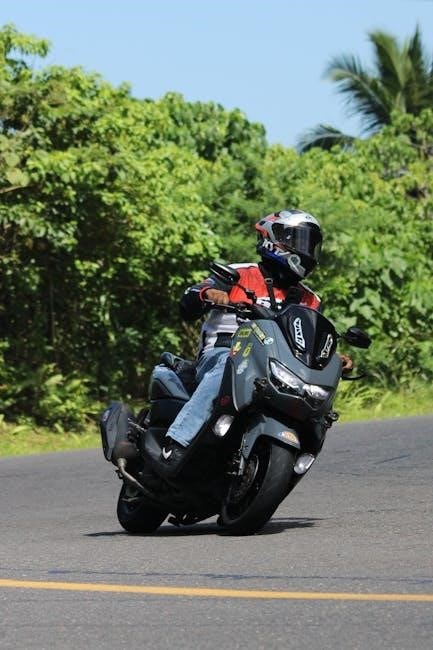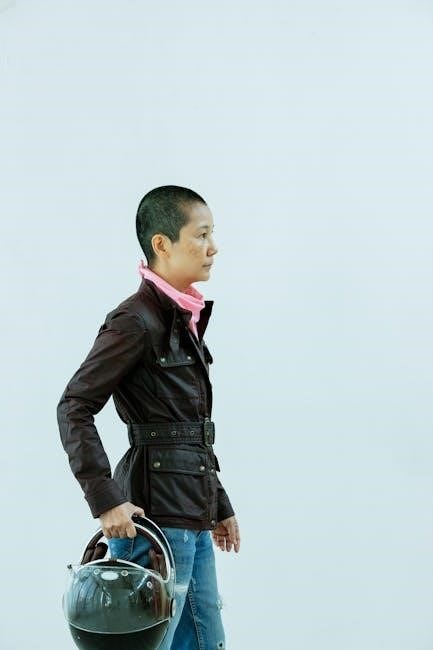An essential guide to selecting the perfect motorbike jacket, ensuring safety, comfort, and style. Explore jacket types, materials, and measurement tips to make an informed decision.
Importance of Proper Fit for Safety and Comfort
A well-fitting motorbike jacket is crucial for both safety and comfort. A snug fit ensures that built-in armor stays in place during impact, providing optimal protection. Loose jackets can compromise safety, as shifting armor may fail to protect vital areas. Proper fit also enhances mobility, allowing riders to control their bike effortlessly. A jacket that is too tight can restrict movement and cause discomfort, especially on long rides. Conversely, a jacket that is too loose may flap in the wind, causing distractions. A correct fit balances protection and flexibility, ensuring a safe and enjoyable riding experience. Prioritizing proper fit is essential for every rider.
Overview of Motorbike Jacket Types and Materials
Motorbike jackets come in various styles and materials, each designed for specific riding conditions. Leather jackets are durable and offer excellent abrasion resistance, making them a popular choice for safety. Textile jackets, often made from nylon or polyester, provide versatility and weather resistance. Mesh jackets prioritize breathability, ideal for hot climates, while hybrid jackets combine materials for adaptability. Each type caters to different needs, whether it’s protection, comfort, or style. Understanding the materials and their benefits helps riders choose the right jacket for their riding style and environmental conditions, ensuring optimal performance and safety on the road.
Understanding Motorbike Jacket Measurements
Accurate measurements are crucial for a proper fit. Key measurements include chest, waist, sleeve length, and body length, ensuring safety, comfort, and optimal protection while riding.
Chest Measurement: How to Measure Accurately
To ensure a proper fit, measure your chest by wrapping a tailor’s measuring tape around the fullest part of your chest. Stand upright and keep the tape snug but not tight, ensuring it’s parallel to the floor. This measurement is critical for determining your jacket size, as it directly impacts both comfort and protection. For accuracy, avoid measuring over thick clothing or armor. The chest measurement helps you align with the size chart, ensuring the jacket fits securely while allowing freedom of movement. A well-fitting chest area guarantees optimal protection and comfort, especially when riding in various positions.
Waist Measurement: Finding the Narrowest Point
To measure your waist accurately, locate the narrowest point of your torso, typically just above your belly button. Wrap the measuring tape around this area, ensuring it’s parallel to the floor and not too tight. This measurement is crucial for determining how the jacket will fit around your midsection. A proper waist measurement ensures the jacket isn’t too restrictive or overly loose, balancing comfort and protection. For the most accurate result, measure over light clothing, such as what you’d wear while riding. Avoid twisting the tape, as this can lead to incorrect sizing. This step ensures your jacket fits securely and comfortably, enhancing your riding experience.
Sleeve Length Measurement: Shoulder to Wrist
Measure sleeve length from the top of your shoulder to your wrist, following your arm’s natural curve. For accuracy, slightly bend your arm and keep your elbow relaxed. This ensures the jacket sleeves will fit comfortably while riding, allowing full mobility. Proper sleeve length prevents restrictive movement and ensures built-in armor stays in place. Measure over light clothing, like a base layer, to simulate riding conditions. Avoid stretching the tape too tight or letting it sag, as this can lead to an ill-fitting jacket. Accurate sleeve length is vital for both comfort and protection, ensuring optimal coverage during your ride.
Body Length Measurement: Optimal Coverage
Measure body length from the base of your neck to your hipbone or the top of your thigh for optimal coverage. This ensures the jacket protects your torso during rides. Stand upright and use a flexible tape to get an accurate reading. The jacket should cover your lower back when seated, preventing gaps. Proper length enhances safety and comfort, especially in various riding positions. Measure over light clothing to simulate real conditions. Avoid twisting or pulling the tape, as this can distort the measurement. Accurate body length ensures the jacket stays in place, providing consistent protection and a comfortable fit while riding.

Motorbike Jacket Types and Their Size Considerations
Motorbike jackets vary by type, with leather, textile, and mesh options offering unique fit factors. Each material and style requires specific sizing considerations for optimal comfort and protection.
Leather Jackets: Fit and Sizing Tips
Leather jackets are durable and protective but require precise sizing. They often stretch slightly over time, so opt for a snug fit initially. Measure your chest, waist, and sleeve length accurately, ensuring the jacket allows freedom of movement. Consider the riding position, as a too-tight jacket may restrict arm mobility. Check brand-specific size charts, as leather sizing can vary. Look for jackets with adjustable features like waist straps or cuffs for a tailored fit. Try the jacket with riding gear, such as gloves, to ensure comfort. Leather jackets may need a break-in period, but proper sizing ensures safety and comfort on the road.
Textile Jackets: Measuring for the Right Fit
Textile jackets offer flexibility and breathability, making them ideal for various riding conditions. To ensure the right fit, measure your chest, waist, and sleeve length accurately. Textile jackets often have adjustable features like cuffs and hem, allowing for a tailored fit. Consider your riding position, as the jacket should not restrict movement. The fit should be snug but comfortable, with room for layering if needed. Use a size chart specific to the brand and jacket type, as textile sizing can vary. Ensure the jacket is worn over typical riding gear to assess the fit properly. Proper measurement ensures optimal comfort and protection while riding.
Mesh Jackets: Size Chart Differences
Mesh jackets are designed for breathability and lightweight comfort, ideal for warm weather riding. Their size charts differ from leather or textile jackets due to the flexible, stretchable material. Measurements focus on chest, waist, and sleeve length, but with a slightly looser fit to accommodate airflow. Some brands offer adjustable features like zippered vents, which can affect sizing. When measuring, consider wearing lightweight base layers, as mesh jackets are typically worn without bulky gear. Size charts may vary between brands, so always refer to the specific manufacturer’s guide. Proper fit ensures maximum ventilation and comfort without compromising protection or mobility while riding.
Hybrid Jackets: Combining Materials and Fit
Hybrid jackets blend materials like leather, mesh, and textiles, offering versatility for varying weather conditions. Their size charts reflect this mix, with measurements tailored to balance flexibility and protection. Fit varies by design, with some hybrids emphasizing aerodynamics and others prioritizing comfort. Accurate body measurements are crucial, as the combination of materials can affect how the jacket sits on the body. Consult brand-specific size guides, as hybrid jackets may have unique sizing due to their multi-material construction. Proper fit ensures optimal performance, whether riding in hot or cool climates, making hybrids a practical choice for adaptable riders seeking both style and functionality.
Jacket Fit Styles: Choosing the Right One
Explore sport, regular, and relaxed fits, each designed for specific riding styles. Sport fit offers aerodynamics, regular balances comfort and protection, while relaxed prioritizes freedom of movement.
Sport Fit: Designed for Aerodynamics
Sport-fit jackets are tailored to hug the body tightly, reducing wind drag for aggressive riders. Ideal for sportbike riders, this fit enhances aerodynamics and provides optimal protection. The snug design keeps armor in place during high-speed maneuvers, ensuring safety and control. Riders in forward-leaning positions benefit most from this style, as it minimizes air resistance and maximizes performance. While it offers less flexibility than other fits, the sport fit is perfect for those prioritizing speed and precision. Measure accurately to ensure a comfortable yet firm fit, as this style is designed to move with the rider seamlessly.
Regular Fit: Balancing Comfort and Protection
Regular-fit jackets offer a balance between comfort and protection, making them a versatile choice for most riders. They provide ample movement while maintaining essential safety features. Designed for everyday riding, this fit is neither too tight nor too loose, ensuring freedom of movement without compromising on protection. Ideal for riders who prioritize both comfort and functionality, regular-fit jackets are suitable for various riding styles. They often include adjustable features, allowing customization for a personalized fit. This style is perfect for those seeking a practical and comfortable option that meets the demands of both urban and touring environments.

Relaxed Fit: Prioritizing Comfort
Relaxed-fit jackets prioritize comfort, offering a looser design for maximum freedom of movement. Ideal for cruiser riders or those seeking a casual style, this fit provides ample room around the chest, waist, and arms. It allows for layering underneath, making it perfect for varying weather conditions. The relaxed fit reduces restriction, enabling a more natural riding position and minimizing fatigue on long rides. While it emphasizes comfort, it still maintains essential protective features, ensuring safety without sacrificing practicality. This style is a great choice for riders who value ease and flexibility while enjoying their journeys.

How to Measure Yourself for a Motorbike Jacket
Use a tailor’s tape to measure chest, waist, and sleeve length. Ensure accurate fit by wearing similar clothing as when riding for optimal protection and mobility.
Using a Tailor’s Measuring Tape
Accurate measurements are crucial for the perfect fit. Wrap the tape snugly around your chest at its fullest point, ensuring it’s level and not too tight. For the waist, measure the narrowest part of your torso, just above the belly button. Sleeve length is measured from the shoulder’s top to the wrist, following your arm’s natural curve. Use the tape without bulky clothing for precise results. This method ensures your jacket fits comfortably while riding, providing optimal protection and mobility. Always refer to the size chart after measuring to select the correct size for your motorbike jacket.
Measuring with a Friend’s Assistance
Enlist a friend to help ensure accurate measurements for your motorbike jacket. They can wrap the tape around your chest at its fullest point, ensuring it’s snug and level. For the waist, have them measure the narrowest part of your torso, just above the belly button. Sleeve length is measured from the top of your shoulder to your wrist, following your arm’s natural curve. Wearing lightweight, fitted clothing during measurement helps achieve precise results. A friend’s assistance can provide more accurate readings, especially for hard-to-reach areas, ensuring your jacket fits perfectly for both comfort and protection while riding.
Wearing Appropriate Clothing for Measurement
When measuring for a motorbike jacket, wear lightweight, fitted clothing to ensure accurate results. Avoid bulky garments that could distort measurements. For chest and waist, a thin t-shirt or tank top is ideal. Sleeves should be short or rolled up to allow the tape to glide smoothly from shoulder to wrist. Wearing similar underlayers as you would while riding helps replicate the fit you’ll need. This ensures the jacket’s armor stays in place and provides optimal protection. Proper attire during measurement is crucial for a jacket that balances comfort, mobility, and safety, making your riding experience more enjoyable and secure.
Interpreting Motorbike Jacket Size Charts
Match your body measurements to the chart, considering chest, waist, and sleeve length. Note brand variations and refer to product-specific guides for accurate sizing.
Matching Body Measurements to Jacket Sizes
Accurately align your chest, waist, and sleeve measurements with the size chart to ensure a proper fit. Measure chest at the fullest point, waist at the narrowest, and sleeves from shoulder to wrist. Compare these to the chart, noting that sizes may vary slightly between brands. Consider the jacket type—leather, textile, or mesh—as each may have unique sizing. Ensure the fit allows for freedom of movement while maintaining protection. If your measurements fall between sizes, consider the intended use and adjust accordingly. Always refer to the specific brand’s size guide for the most accurate fit, as standards can differ significantly.
Understanding Size Variations Between Brands
Motorbike jacket sizes can vary significantly between brands due to differences in design, materials, and fit styles. While one brand may offer a relaxed fit, another may cater to sport or slim silhouettes. Leather jackets, for instance, may have less stretch compared to textile or mesh options, affecting sizing. Always refer to the specific brand’s size chart, as measurements are not universal. Some brands, like Revzilla or Merlin, provide detailed guides to help match your body measurements to their jacket sizes. Material thickness and built-in armor can also influence fit, so checking product-specific sizing is crucial for accuracy and comfort;
Importance of Checking Product-Specific Size Guides
Checking product-specific size guides is crucial for ensuring the best fit, as sizing can vary between brands and jacket types. Each manufacturer tailors its size charts to the unique design, material, and intended use of the jacket. For example, leather jackets may fit differently than mesh or textile ones due to material stretch and thickness. Built-in armor and padding can also affect how a jacket fits. By referring to the specific size guide provided by the brand, you can match your measurements accurately and avoid sizing errors. This step ensures optimal comfort, protection, and mobility, making your riding experience safer and more enjoyable.

Factors Influencing Jacket Size and Fit
Built-in armor, layering, and riding position significantly impact jacket fit. Armor adds bulk, while layering affects tightness. Riding posture requires precise measurements for optimal comfort and protection.

Impact of Built-In Armor on Sizing
Built-in armor significantly affects motorbike jacket sizing. Armor adds bulk, requiring adjustments to chest, shoulder, and elbow measurements. A snug fit ensures protection without restricting movement. Proper sizing accounts for armor placement to maintain safety and comfort. Always refer to brand-specific size charts, as armor integration varies. Accurate measurements are crucial to avoid a too-tight or too-loose fit. Consider armor type and placement when selecting your jacket size for optimal protection and mobility during rides.
Layering Clothing: How It Affects Fit
Layering clothing beneath a motorbike jacket can significantly impact its fit. Thicker layers, such as sweaters or thermals, add bulk to your torso, which may require sizing up for comfort. Conversely, lightweight base layers may not affect sizing as much. Always consider the clothing you’ll wear while riding when measuring for your jacket. Leather and textile jackets offer varying degrees of flexibility, so layering should be tested to ensure the jacket remains snug but not restrictive. Proper fit with layers ensures optimal protection and mobility, making it essential to account for layering when selecting your jacket size.

Riding Position and Jacket Fit
Riding position significantly impacts motorbike jacket fit. Sport riders in aggressive, forward-leaning positions need jackets with articulated sleeves and flexible shoulders for ease of movement. Cruiser riders, sitting upright, may prefer jackets with a relaxed fit for comfort. Touring riders benefit from jackets with adjustable features, such as sleeves and hem, to accommodate varying positions. Ensure the jacket fits snugly when in your primary riding position to maintain protection and mobility. A poor fit due to riding position can compromise safety and comfort, so consider your riding style when selecting a jacket size and design.

Tips for Choosing the Right Motorbike Jacket Size
Ensure a perfect fit by measuring accurately, considering riding position, and checking size charts. Try jackets on if possible and read reviews for fit feedback to make an informed decision.
Trying Before Buying: Ensuring the Best Fit
Trying on a motorbike jacket before purchasing is crucial for ensuring the best fit. A well-fitting jacket enhances safety, comfort, and mobility while riding. When trying it on, sit in a riding position to check flexibility and mobility. The jacket should feel snug but not restrictive, with armor staying in place. Consider the material—leather jackets may stretch slightly over time, while textile jackets offer consistent fit. If trying on isn’t possible, use detailed size charts and reviews to guide your decision. A proper fit ensures optimal protection and comfort, making it essential to prioritize this step in your purchase process.
Considering Brand-Specific Sizing Differences
Motorbike jacket sizing can vary significantly between brands, making it essential to consult brand-specific size charts. Each manufacturer may have unique measurements for chest, waist, and sleeve lengths. For example, a size medium in one brand might fit differently in another. Always refer to the brand’s size guide, as some may cater to specific body types or riding styles. Additionally, materials like leather or textile can affect fit, with leather jackets often stretching over time. To avoid sizing mismatches, compare your measurements to the brand’s chart and read reviews for insights into how others perceive the fit. This ensures a tailored choice for optimal comfort and protection.
Reading Reviews for Fit Feedback
Reading reviews from other riders is a valuable step in ensuring the best fit for your motorbike jacket. Real-world feedback provides insights into how a jacket fits, accounting for brand-specific sizing variations. Riders often share details about whether a jacket runs small, large, or true to size, helping you make informed decisions. Reviews also highlight comfort, mobility, and how the jacket performs in different riding conditions. Pay attention to comments about armor placement, sleeve length, and overall comfort, as these factors directly impact your riding experience. By leveraging the experiences of others, you can avoid sizing mismatches and select a jacket that meets your needs for both safety and comfort.

Material-Specific Sizing Considerations
Leather jackets may stretch over time, while textile jackets offer consistent fit. Mesh jackets prioritize breathability, often fitting slightly looser for airflow and comfort during rides;
Leather Jackets: Stretch and Fit
Leather jackets naturally stretch over time, offering a snug, tailored fit initially that relaxes with wear. To ensure optimal protection and comfort, measure your chest accurately, considering the jacket’s armor placement. Leather jackets should fit tightly but not restrict movement; a slightly firm fit allows for the material’s give. When trying on, wear similar underlayers to your riding gear for an accurate fit. Note that leather jackets may require a break-in period to achieve the perfect balance of comfort and protection. Proper fit ensures safety features like armor stay in place, while allowing freedom of movement for control while riding.
Textile Jackets: Flexibility and Sizing
Textile jackets offer exceptional flexibility and comfort, making them ideal for various riding conditions. Unlike leather, textiles provide a softer, more pliable fit right away, with less break-in needed. When sizing, consider your chest and waist measurements to ensure a snug yet comfortable fit. Textile jackets often feature adjustable cuffs and hem, allowing for a customizable fit. They are also lightweight and breathable, suitable for warmer weather. Look for jackets with built-in armor for added protection without sacrificing flexibility. Proper sizing ensures optimal mobility and safety, making textile jackets a versatile choice for everyday riding and long-distance tours alike.

MESH Jackets: Fit and Breathability
MESH jackets are designed for maximum breathability, making them ideal for hot weather riding. Their lightweight, ventilated design ensures airflow, keeping you cool and comfortable. The fit is typically more relaxed to accommodate the flexible mesh material, which stretches naturally for ease of movement. When sizing, consider your chest and waist measurements to ensure a comfortable fit without restriction. MESH jackets are perfect for riders prioritizing ventilation and lightweight protection. However, they may offer less structural support compared to leather or textile jackets. Always check size charts and reviews to ensure the best fit for your riding needs and preferences.
Caring for Your Motorbike Jacket
Proper care ensures your motorbike jacket lasts longer, maintaining its protective qualities and comfort. Regular cleaning, proper storage, and avoiding harsh chemicals are essential for preserving its condition.
Cleaning and Maintenance Tips
Proper cleaning and maintenance are crucial for extending the life of your motorbike jacket. For leather jackets, use a soft brush to remove dirt and apply mild soap with a damp cloth. Avoid harsh chemicals or abrasive materials that can damage the finish. Textile jackets can often be machine washed on a gentle cycle, but always check the care label. Mesh jackets require gentle hand washing to maintain breathability. Regularly inspect armor and padding for wear. Store your jacket in a cool, dry place away from direct sunlight. Avoid folding or creasing to prevent damage. Regular maintenance ensures your jacket remains protective and comfortable for years.
Storage Recommendations
Proper storage is essential to maintain your motorbike jacket’s quality and fit. Store it in a cool, dry place away from direct sunlight to prevent fading or material degradation. Avoid folding or hanging, as this can cause creases or stretch the fabric. For leather jackets, use a sturdy hanger with padding to maintain shape. Textile and mesh jackets can be stored flat or hung using a broad shoulder hanger. Consider using a breathable storage bag to protect against dust. Ensure the jacket is clean and dry before storage to prevent mold or mildew. Regularly inspect stored jackets to ensure they remain in optimal condition for your next ride.
Ensuring Longevity of Fit and Quality
To maintain your motorbike jacket’s fit and quality, regular maintenance is crucial. Clean the jacket according to the material-specific instructions, avoiding harsh chemicals that could damage the fabric or armor. For leather jackets, use a conditioner to prevent cracking, while textile jackets may require waterproofing treatments. Avoid exposing the jacket to extreme temperatures or direct sunlight for extended periods, as this can cause fading or material degradation. Store the jacket properly when not in use, using a breathable bag or hanging it on a sturdy hanger. Regularly inspect for wear and tear, and address any damage promptly to ensure the jacket remains protective and comfortable for years to come.
By following this guide, riders can confidently select a motorbike jacket that balances safety, comfort, and style, ensuring an optimal riding experience every time.
Summarizing Key Points for the Perfect Fit
Accurate measurements are crucial for a motorbike jacket to ensure safety and comfort. Measure chest, waist, and sleeve length precisely, considering riding posture. Choose jacket types (leather, textile, mesh) based on weather and riding style. Sport, regular, and relaxed fits cater to different needs. Built-in armor and layering affect sizing. Always refer to brand-specific size charts, as sizes vary. Try jackets before buying if possible, and read reviews for fit feedback. Proper fit ensures protection, mobility, and comfort, making it essential for an enjoyable and safe riding experience. Prioritize quality materials and styles that match your riding habits for optimal results.
Final Tips for a Comfortable and Safe Ride
A well-fitting motorbike jacket is essential for both safety and comfort. Always prioritize jackets with built-in armor and ensure proper fit to avoid restricted movement. Consider layering options for varying weather conditions and choose materials that suit your riding style. Check size charts and try jackets on if possible to confirm fit. Read reviews for insights into real-world comfort and durability. Prioritize visibility with reflective elements and weather-appropriate features. Regularly maintain your jacket to ensure longevity and performance. By combining these tips, you can enjoy a safe, comfortable, and enjoyable riding experience tailored to your needs and preferences.